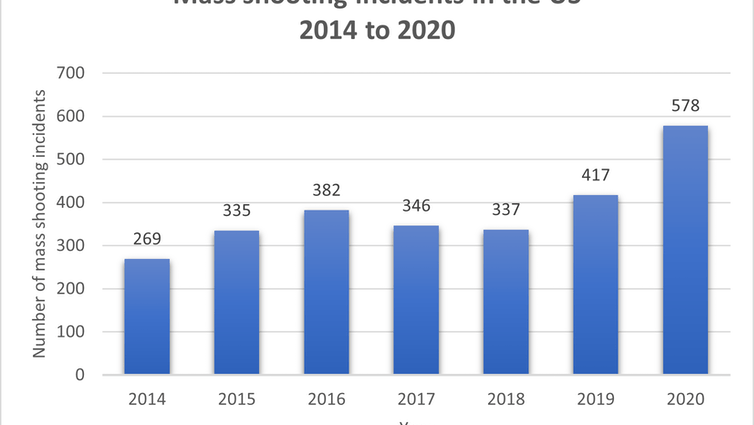Despite the US response to the coronavirus pandemic using sporadic stay-at-home orders and lockdowns, as at November 26 2020 there have been 578 mass shootings so far this year. According to data provided by the Gun Violence Archive, which records mass shooting deaths, this is already significantly above the 417 mass shootings recorded in the whole of 2019.
In fact, by August 2020, mass shootings in the US had already exceeded the year-end totals for each year from 2014 to 2018. Mass shootings in the US have continued the general year-on-year increase in terms of frequency, fatalities and injuries – but 2020 has been far worse than usual.
The Gun Violence Archive defines mass shootings as a minimum of four victims shot (either fatally or not) excluding any shooter killed or injured in the attack. The foundation definition of mass shooting also excludes incidents related to criminal activity, family disputes or gangs.
Data from the Gun Violence Archive, Author provided
There are more conservative measures of mass shooting with higher fatality and injury thresholds available at both the Mother Jones and the Mass Shootings in America databases. But all show an increase – part of a broader trend which has recently increased sharply.
There are a number of reasons behind this: people’s concern that law enforcement and the criminal justice system are not coping with a growing crime-wave while COVID depletes police numbers. There are also those who believe that law enforcement is not working fairly or effectively for them. A lot of these people are prompted to buy themselves guns. Mass gatherings and protests have also involved firearms being brandished and open-carry laws being used to maximum advantage and intimidation. As a Harvard study from 2015 has shown, put simply, more guns equals more homicides.
In September the FBI identified the election period up to the 2021 inauguration as a “potential flashpoint”, issuing an intelligence report warning of an imminent “violent extremist threat” from far-right militias, including white supremacists such as the Boogaloo Boys.
Read more:
Far-right ‘boogaloo’ movement is using Hawaiian shirts to hide its intentions
Research generally shows that more guns in circulation typically results in more mass shootings occurring, but this correlation alone – while important – does not explain why such attacks happen. Other countries with similar gun-ownership rates to the US have considerably fewer mass shootings – so there is clearly something cultural at play.
More guns
An increase in firearm sales in the US at the start of the coronavirus pandemic especially involving “first-time buyers” helped to partially explain the rise in mass shootings, reaching 1.3 million handguns and 700,000 rifles and shotguns sold by August 2020. This was an increase of 60% over average US sales, with August gun sales being the fifth highest month on record according to FBI data.
With demand for firearms increasing, the FBI’s National Instant Criminal Background Checks System (NICS) struggled to keep up and provide sellers with definitive background check decisions within the required time. This legal loophole in the system allowed sellers to use their own discretion to sell (or not) when background checks of purchasers came back from NICS as “inconclusive”.
In some states, gun sales increased massively in the pandemic period: the District of Columbia and and Michigan recorded increases in sales of 449% and 200% respectively between August 2019 and August 2020, according to FBI background check data. In Michigan, gun sales actually dropped 19% between 2018 and 2019 before massively increasing.
In addition to known gun sales data, sales of guns not registered or recorded – those bought at gun fairs and garage sales, for example, as well as online “ghost guns” (legal-to-purchase firearms that come in “kit form” and require assembly by the purchaser and not yet defined by the Bureau of Alcohol, Tobacco and Firearms (ATF) as “firearms”) must also be considered.
More problems
There are are many types of mass shooting and they are not homogeneous. The reasons and mechanics behind school shootings are not the same as attacks in workplaces or public spaces. Some attackers seek infamy and attention – and tend to kill more victims than other mass shooters as a result of their desire to “make the news”. Others have extreme ideological beliefs or hatred of people who may be unlike themselves.
Severe mental health problems are behind less than 30% of active shooter attacks. Many others kill because of narcissistic or disordered personalities which make them feel that mass shooting is the way to resolve their distress in life. Personality disorders are not mental heath problems and are classified separately from severe mental health problems and psychosis – the vast majority of mass shooters fully comprehend what they are doing.
In the majority of mass shooting perpetrators, there were clearly identified triggering events which caused intolerable distress that pushed individuals into action – making their fantasies become a reality.
With increased gun sales and the number of mass shootings already extremely high, we can expect many more in coming months. Research has shown the “contagion phenomenon” is true – mass shootings lead to other mass shootings, through general awareness and sensationalist news reporting that creates anti-hero figures of mass shooters, appealing to others who have considered undertaking mass shootings themselves.
The febrile climate in the US will encourage some potential mass shooters to undertake attacks – and these may involve targets, victims and locations different from those typically involved, due to lockdown restrictions forcing attackers to go to where large numbers of potential victims will be.
Schools, federal buildings and places of worship only account for 25%, 10% and 4% of mass shooter incidents respectively – with commercial and retail premises accounting for almost 50% of attacks. These will remain attractive targets to mass shooters when densely populated and while access to firearms remains relatively easy.
![]()
Craig Jackson does not work for, consult, own shares in or receive funding from any company or organisation that would benefit from this article, and has disclosed no relevant affiliations beyond their academic appointment.











